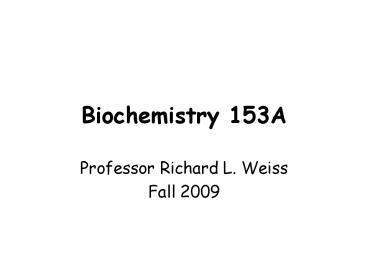Biochemistry 153A PowerPoint PPT Presentation
1 / 54
Title: Biochemistry 153A
1
Biochemistry 153A
- Professor Richard L. Weiss
- Fall 2009
2
INTRODUCTION
3
BiochemistryThe Study of Life on the Molecular
Level
- Bio Life
- Chemistry Property of Molecules
4
What You Will Learn
- Composition , structures and functions of
proteins, carbohydrates, and lipids - Principles of enzyme catalysis
- Central metabolic pathways of energy transduction
- Beginning of an understanding of the integrated
picture of life and its basis in chemistry.
5
Principles of Enzyme Catalysis
- The role of proteins as enzymes
- Enzyme kinetics
- Catalytic mechanisms
- Regulation of enzyme catalysis
6
Central Metabolic Pathways of Energy Transduction
- Glycolysis
- Tricarboxylic Acid Cycle(TCA Cycle Krebs Cycle
Citric Acid Cycle) - Electron Transport Chain
- Oxidative Phosphorylation
7
Properties of Life(Norman Horowitz)
- Replication
- Catalysis
- MutabilityOrganisms
8
Cells(Basis for Life)
- Prokaryotes lack nucleus
- Eucaryotes membrane-enclosed nucleus
9
Procaryotes(e.g. Escherichia coli)
- Adapted to fluctuating environments
10
Procaryote Shapes
Figure 1-7
11
Procaryote Structure
Figure 1-6
12
Metabolic Energy Sources
- Autotrophs (self-feeding) synthesize all
cellular constituents - Chemolithotrophs oxidation of inorganic
compounds - Photoautotrophs photosynthesis
- Heterotrophs (other-feeding) dependent on
autotrophs - oxidation of organic compounds - Obligate aerobes
- Facultative anaerobes
- Obligate anaerobes
13
Eucaryotes(e.g. Saccharomyces cerevisiae or
human cells)
- Adapted to stable environments
14
Eucaryotes(Differences with Procaryotes)
- Increased complexity gt10,000 rxns vs. 3,000
rxns - Increased size 103 106 x volume
- Smaller surfacevolume ratio
- Membrane-enclosed organelles
- Increased solvent capacity
- Increased membrane surface
- Compartmentation
15
Eucaryotic Cell Structure
Figure 1-8
16
Evolutionary Relationships
Figure 1-9
17
Fundamental Similarity of Biological Processes
- Procaryotes
- Eucaryotes
18
Advantages of Studying Microorganisms
- Ethics
- Availability of large numbers of identical
individuals - Ease of manipulation
- Genetics
- Molecular Biology
- Inexpensive
19
Principles of Biochemistry
- Genetic Hypothesis
- Central Dogma (of Molecular Biology)
- Enzyme Hypothesis
- Energy Hypothesis
- Spontaneous Self-Assembly Hypothesis
20
Genetic Hypothesis
DNA as the Genetic Material
21
Central Dogma(of Molelcular Biology)
Figure 3-13
22
Enzyme Hypothesis
23
Energy Hypothesis(Biological Transformations)
- Catabolism exergonic oxidation
- Anabolism endergonic processes
24
Anabolism and Catabolism(Heterotrophs)
25
ATP
26
Sources of ATP
- Phototrophs photosynthesis
- Chemotrophs oxidation of organic compounds
(e.g. carbohydrates, lipids, and proteins)
27
Figure 1-11
28
Spontaneous Self-Assembly Hypothesis
29
Characteristics of Biomolecules
- Self-Replication
- Self-Assembly
- Self-Regulation
30
Self-Replication(Based on Templates)
Complementarity
31
Complementarity within Molecules
Figure 1-5
32
Self-Assembly
- Micromolecules gt Macromolecules
- Macromolecules gt Macromolecular Assemblies
33
Self-Regulation
34
Thermodynamics versus Kinetics
35
Complexity of Biomolecules
- Requirement for Structural Diversity
36
Composition of a Typical Bacterial Cell
Simply learning structures appears to be a
monumental task!
37
Principle of Structural Simplicity
38
Biopolymers
- Types
- Homopolymers
- Heteropolymers
- Length and Branching
- Linear homopolymers
- Branched homopolymers
- Linear heteropolymers
- Branched heteropolymers
39
Homopolymers
Linear Homopolymer
Branched Homopolymer
40
Heteropolymers
Linear Heteropolymer
Branched Heteropolymer
41
Biological Macromolecules
42
Proteins(Amino Acids)
Only 20 naturally-occurring amino acids Only
linear structures
43
Polysaccharides(Sugars)
Only a few sugars (8) Linear and branched
molecules
44
Lipids (Various Precursors)Neutral Lipids
45
Lipids (Various Precursors)Phospholipids
46
Nucleic Acids(Nucleotides)
47
Combinations
- e.g.
- Glycoproteins
- Glycolipids
48
Macromolecules are composed of polymers of a few
simple precursor molecules
49
Structural Diversity
50
Proteins
- aa1aa2aa3aan
- Number of structures 20n
- 100 amino acids per molecule
- 20100 molecules
51
Nucleic Acids
- N1N2N3Nn
- Number of structures 4n
- 1,000,000 nucleotides per DNA molecule
- 41,000,000 molecules!!!
52
Polysaccharides
- Homopolymers and Heteropolymers
- Many different sugar molecules
- Linear and branched
- Many different molecules!!!
53
Lipids
- Many complex molecules!!!
54
Simple construction provides an immense number of
possible structures fully capable of providing
the necessary diversity required for life.

